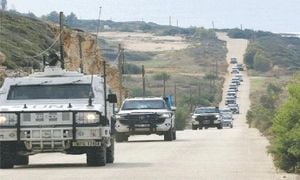Isaiah Thompson and Shawn Herron, both in their twenties and living in Las Vegas, never imagined they would be relying on blood plasma donations to pay the bills. But as the city’s job market has cratered, that’s exactly what they—and a growing number of their neighbors—have resorted to in order to make ends meet.
According to Las Vegas Review-Journal and other local outlets, Thompson has been searching for work for months, submitting at least 20 job applications a day, several days each week. Despite his relentless efforts, he’s come up empty-handed. Herron’s story is much the same: after applying to more than 100 jobs, he finally landed a warehouse gig, but not before months of uncertainty and financial strain. In the meantime, both men turned to selling their plasma, with Thompson estimating he could make upwards of $800 a month this way—a sum that, for now, is enough to cover his rent.
“It was easy to find a job three or four years ago, but Las Vegas’ job market is honestly terrible now,” Thompson told Las Vegas Review-Journal in September 2025. “If someone has work, they better hold on to it.” Herron echoed the sentiment, adding, “Once it’s gone, it’s hard to find another job.”
Their experiences are far from unique. As reported by Daily Mail and corroborated by state employment data, Las Vegas lost between 4,300 and 4,400 jobs in August 2025 compared to the previous month. The construction sector was hit especially hard, shedding 4,400 jobs—the worst loss in the nation by both raw number and percentage. Nevada’s private sector as a whole lost 6,000 jobs between July and August, and the state’s unemployment rate climbed to 5.6% in August, ranking as the fourth worst among U.S. metropolitan areas with fewer than one million residents.
Behind these stark statistics lies a troubling trend: the city’s lifeblood—tourism—is faltering. Fewer visitors are coming to Las Vegas, a phenomenon that is rippling through the entire state economy. From January through August 2025, tourism to Las Vegas dropped by 7.8% compared to the same period in 2024. That’s not just a blip; in a state where tourism contributed nearly $100 billion to the economy in 2024, supported about a quarter of all jobs, generated 22% of wages, and accounted for 34% of tax dollars, a decline of this magnitude is seismic.
Why are tourists staying away? According to Daily Mail, many cite soaring prices for hotels, food, drinks, and casinos—expenses that some have labeled “extortionate.” Visitors from Canada, a key market for Las Vegas, have reportedly been boycotting the city in response to political tensions, further shrinking the pool of potential guests.
As tourism revenue dries up, the dominoes fall across Nevada’s industries. The real estate sector, the state’s second-largest economic engine after tourism and hospitality, has also been affected. Sales at food and beverage outlets in Clark County, where Las Vegas is located, slipped 2% between June 2024 and June 2025—a loss of $256.5 million. Even a seemingly small percentage drop translates to major losses for local businesses and workers.
The impact is visible on the ground. Bars like the Poker Palace are eerily quiet, with some venues set to close. Job fairs are drawing crowds of desperate candidates, all vying for a shrinking pool of employment opportunities. According to David Schmidt, chief economist at the Nevada Department of Employment, Training and Rehabilitation, the food services industry was hit hardest after construction. He noted that while hiring hasn’t fallen off a cliff, it has “leveled off.” Layoffs are increasing, and fewer people are quitting their jobs—likely out of fear that finding new work will be next to impossible.
On a broader scale, Nevada’s labor market is described by state officials as “largely stationary.” Year-over-year, the state lost 1,303 jobs in August, which, while statistically insignificant, underscores the stagnation. The overall U.S. job market isn’t faring much better: in August 2025, the country added only 22,000 jobs year-over-year—a mere 0.93% increase. For comparison, the U.S. added 142,000 jobs the previous August and 187,000 the year before that, according to the Bureau of Labor Statistics.
For workers like Thompson and Herron, these numbers translate into a daily grind of uncertainty and anxiety. Plasma donation centers, once a niche option for extra cash, have become a lifeline for many. “It’s not glamorous, but it’s what’s keeping the lights on,” Thompson said. The process is time-consuming and physically draining, but the payout—up to $800 a month—can mean the difference between making rent and facing eviction.
Las Vegas has always been a city of highs and lows, a place where fortunes can change overnight. But for many residents, the current downturn feels different. The city’s reliance on tourism and hospitality has left it especially vulnerable to economic shocks. As one local economist put it, “When Vegas sneezes, the whole state catches a cold.”
State officials are watching the situation closely, hoping for a rebound in tourism and a stabilization of the job market. There are glimmers of hope: some analysts point to major events and conventions scheduled for late 2025 and 2026 as potential catalysts for renewed visitor interest. But for now, the outlook remains uncertain, and residents like Thompson and Herron are bracing for a long road ahead.
Meanwhile, the stories of those struggling to get by—selling plasma, applying for dozens of jobs each week, and holding tight to whatever work they can find—serve as a stark reminder of the challenges facing Las Vegas. The city’s glittering lights may still beckon, but for many locals, the shine has dimmed, replaced by the harsh reality of an economy in distress.
As the job market remains sluggish and the tourism sector struggles to recover, Las Vegas residents are doing whatever it takes to survive—one plasma donation at a time.




